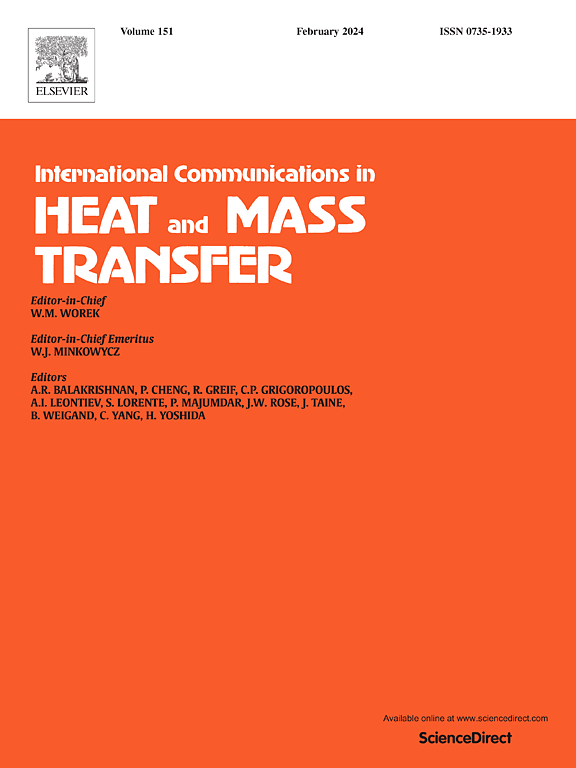旋转机构强化三管潜热蓄热系统熔凝性能及均匀性研究
IF 6.4
2区 工程技术
Q1 MECHANICS
International Communications in Heat and Mass Transfer
Pub Date : 2025-04-08
DOI:10.1016/j.icheatmasstransfer.2025.108952
引用次数: 0
摘要
为了解决不同换热方式在能量充放电过程中产生的难熔区问题,提高三管潜热储能(T-LHTES)系统的热效率和换热均匀性,本文创新性地提出了旋转系统,并首次引入弧形翅片加强换热。通过数值模拟,采用旋转参照系法研究了不同转速下直翅片系统的熔化凝固特性、传热效率和传热均匀性。与非旋转结构相比,在0.1 rpm转速下,系统的充放电时间分别缩短了73.46%和62.09%,效率分别提高了1.55倍和1.59倍,并且随着转速的增加,热均匀性得到了显著改善。15°弧形翅片的使用结合了非对称旋转策略(0.1 rpm充电/ - 0.1 rpm放电)进一步减少了5.63%和2.51%的充电/降温时间,提高了4.74%和2.73%的效率。本研究为主动增强型T-LHTES系统的设计提供了新的思路。本文章由计算机程序翻译,如有差异,请以英文原文为准。
Study on the melting and solidification performance and uniformity of rotating mechanism-enhanced triplex-tube latent heat thermal energy storage system
To solve the problem of refractory zone produced by different heat transfer methods in the energy charging and discharging process, and to improve the thermal efficiency and heat transfer uniformity of the triple tube latent heat energy storage(T-LHTES) system, this paper innovatively proposes a rotating system and introduces the arc-shaped fins to strengthen the heat transfer for the first time. Through numerical simulation, the melting and solidification characteristics, heat transfer efficiency, and heat transfer uniformity of the straight fin system at different rotational speeds are investigated by using the rotating reference system method. Compared with the non-rotating structure, the system's charging and discharging time is shortened by 73.46 % and 62.09 %, respectively, at a rotational speed of 0.1 rpm, and the efficiency is increased by 1.55 times and 1.59 times, respectively, and the thermal uniformity is significantly improved with the increase of rotational speed. The use of 15° arc-shaped fins combined with an asymmetric rotation strategy (charging at 0.1 rpm/ discharging at −0.1 rpm) further reduced charging/de-heating time by 5.63 % vs. 2.51 % and increased efficiency by 4.74 % vs. 2.73 %. This study provides new ideas for the design of actively enhanced T-LHTES systems.
求助全文
通过发布文献求助,成功后即可免费获取论文全文。
去求助
来源期刊
CiteScore
11.00
自引率
10.00%
发文量
648
审稿时长
32 days
期刊介绍:
International Communications in Heat and Mass Transfer serves as a world forum for the rapid dissemination of new ideas, new measurement techniques, preliminary findings of ongoing investigations, discussions, and criticisms in the field of heat and mass transfer. Two types of manuscript will be considered for publication: communications (short reports of new work or discussions of work which has already been published) and summaries (abstracts of reports, theses or manuscripts which are too long for publication in full). Together with its companion publication, International Journal of Heat and Mass Transfer, with which it shares the same Board of Editors, this journal is read by research workers and engineers throughout the world.

 求助内容:
求助内容: 应助结果提醒方式:
应助结果提醒方式:


